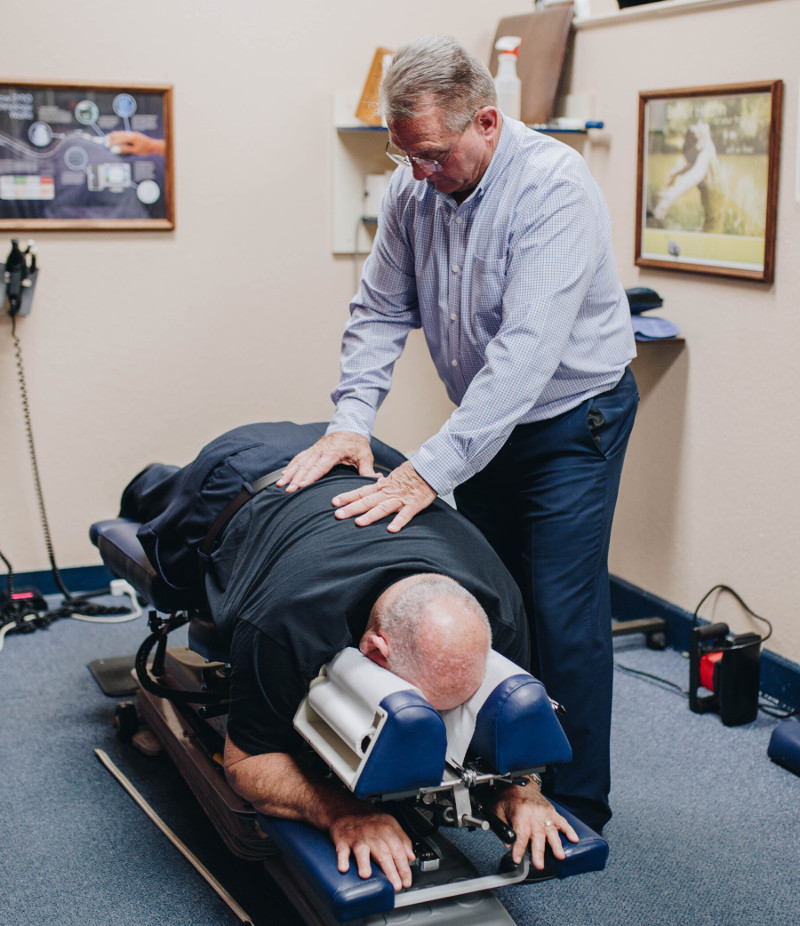Chiropractic Care
Aches and pains are signs your body isn’t working right.
The spine is an important structure that houses and provides protection for the spinal cord, while providing mobility for the upper body. This dual requirement of strength and flexibility makes the spine a very complex structure, with multiple joints at each spinal segment (the vertebrae) forming the spinal column. When these joints (also known as articulations) are not positioned or functioning normally, it can affect the nerves exiting the spine.
Chiropractic care attends to irritations along the spine by manually repositioning these joints. This is a chiropractic “adjustment.” Spinal adjustments relieve pressure from pinched nerves and restore proper communication between the brain and the rest of the body. “Allopathic” medicine treats illness through the use of drugs and surgery, but the focus of chiropractic is to maximize health with a non-invasive approach that utilizes spinal adjustments and therapies to restore alignment and function of the spine. Chiropractors are also licensed to use physical therapy and nutritional interventions to aid the patient in restoring their health. Chiropractic Center of Lakeland offers a holistic alternative for relief from back pain and other illnesses associated with vertebral misalignment.

Chiropractic is a health care delivery system that focuses on the spine by restoring and correcting abnormal spinal alignment.
Our Techniques
Chiropractic Center of Lakeland employs a wide range of proven techniques for each individual case. Below, you’ll find a brief explanation of the popular chiropractic techniques we use at our practice.
The Diversified Technique
This technique is the most commonly used of all chiropractic techniques and most familiar to patients. It involves a hands-on gentle, high-velocity, low-amplitude thrust that usually results in a popping noise as gas is released out of the joint capsule.
Extremity Manipulation
The application of mobilization to joints other than the spine is extremity manipulation. Examples of conditions treated with this method include carpal tunnel, tennis/golfer’s elbow, mild ankle sprains, mild knee sprains, and hip dysfunction.
Trigger Point Therapy
The primary purpose of Trigger Point Therapy is to reduce the pain that results from hypersensitive muscles. Trigger points are identified by gently pressing on the surface of the skin, sensing the texture of the underlying muscle.
Drop Table
This technique makes use of specialized drop-piece mechanisms in the table to assist the adjustment. Individual cushions or “drop pieces” located along the table support each area of the spine until the thrust is given. Then, each drop-piece gently gives way, reducing the pressure needed to move a specific spinal segment.
Corrective Exercise & Rehabilitation
Corrective exercise and rehabilitation techniques are utilized to stretch and strengthen muscles that are contributing to the patient’s problem. Our location near local gyms allows us to utilize various exercise equipment for some of the most complete and effective rehabilitation in the area.
Pettibon Postural Strengthening
This type of postural strengthening focuses on restoration of spinal curvature, especially cervical curvature. By utilizing this unique strengthening technique you can expect a dramatic reduction in neck pain, headaches, shoulder pain, and other postural related symptoms.
Graston Technique
This soft tissue technique utilizes special tools to drastically reduce muscle and tendon pain. This technique is especially effective on tendonitis of all sorts. It is common to experience a 50-75% reduction in pain within 1-2 treatments.
Activator Method Chiropractic Technique
Activator technique is a chiropractic method that is used to treat spinal biomechanical dysfunctions. The adjustment is delivered through a device that is categorized as a mechanical force. This instrument adjustment is usually regarded as a softer chiropractic treatment by some patients.
Nutritional Therapies
Our office employs many nutritional testing methods including Nutrition Response Testing, Body Composition Measurements, Biosignature Modulation, and Blood Work Analysis.